动词不定式被动语态讲解
- 格式:doc
- 大小:68.00 KB
- 文档页数:5
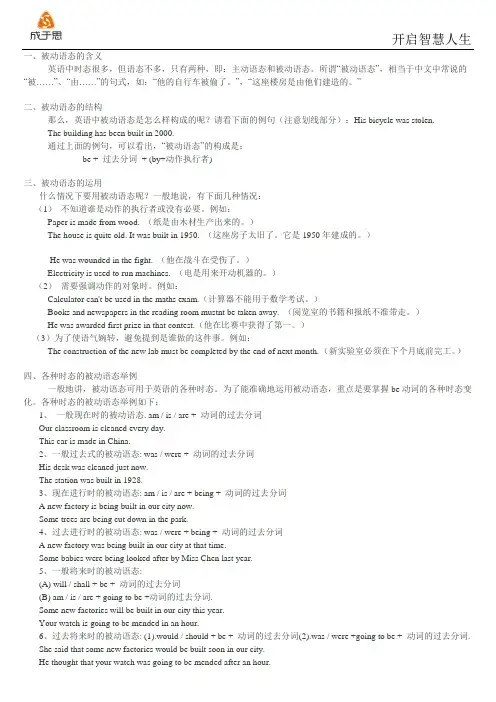
一、被动语态的含义英语中时态很多,但语态不多,只有两种,即:主动语态和被动语态。
所谓“被动语态”,相当于中文中常说的“被……”、“由……”的句式,如:“他的自行车被偷了。
”,“这座楼房是由他们建造的。
”二、被动语态的结构那么,英语中被动语态是怎么样构成的呢?请看下面的例句(注意划线部分):His bicycle was stolen.The building has been built in 2000.通过上面的例句,可以看出,“被动语态”的构成是:be + 过去分词+ (by+动作执行者)三、被动语态的运用什么情况下要用被动语态呢?一般地说,有下面几种情况:(1)不知道谁是动作的执行者或没有必要。
例如:Paper is made from wood. (纸是由木材生产出来的。
)The house is quite old. It was built in 1950. (这座房子太旧了。
它是1950年建成的。
)He was wounded in the fight. (他在战斗在受伤了。
)Electricity is used to run machines. (电是用来开动机器的。
)(2)需要强调动作的对象时。
例如:Calculator can't be used in the maths exam.(计算器不能用于数学考试。
)Books and newspapers in the reading room mustnt be taken away. (阅览室的书籍和报纸不准带走。
)He was awarded first prize in that contest.(他在比赛中获得了第一。
)(3)为了使语气婉转,避免提到是谁做的这件事。
例如:The construction of the new lab must be completed by the end of next month. (新实验室必须在下个月底前完工。
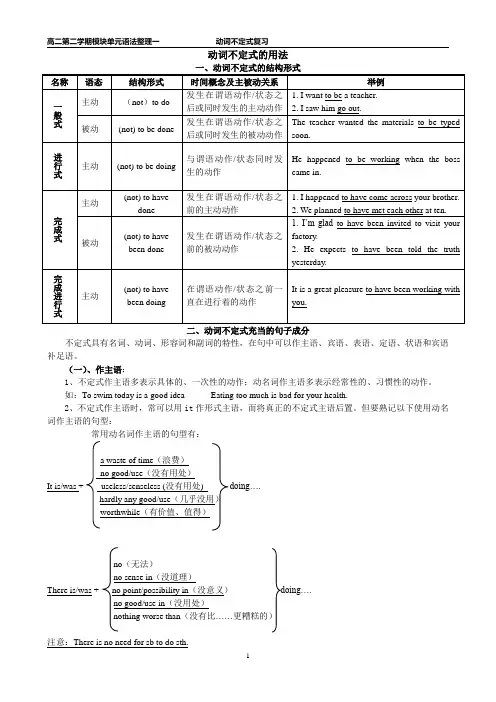
动词不定式的用法二、动词不定式充当的句子成分不定式具有名词、动词、形容词和副词的特性,在句中可以作主语、宾语、表语、定语、状语和宾语补足语。
(一)、作主语:1、不定式作主语多表示具体的、一次性的动作;动名词作主语多表示经常性的、习惯性的动作。
如:To swim today is a good idea Eating too much is bad for your health.2、不定式作主语时,常可以用it 作形式主语,而将真正的不定式主语后置。
但要熟记以下使用动名词作主语的句型:常用动名词作主语的句型有:It is/was +There is/was +更糟糕的)注意:There is no need for sb to do sth.2. 一般情况下,不定式作主语,谓语动词一般用单数形式。
如:To see is to believe.3. 当主语为不定式时,表语也用不定式来表示一致性。
如:To see is to believe.(二)、作宾语1、不定式作宾语通常表示具体的、一次性的动作。
如:Tom likes playing football, but he likes to play basketball today.但需要牢记以下的动词只使用v-ing 为宾语:avoid, miss, delay / postpone, suggest / advise, finish, practice, enjoy/appreciate, imagine, resist, admit, deny, envy, escape / envy, risk, pardon / excuse, keep / keep on, stand, mind;有些动词后面只能接不定式作宾语,如:decide/determine, learn, want, expect/hope/wish, manage, refuse, care, pretend, offer, promise, choose, plan, agree, ask/beg, help, wait, happen, afford, fail, threaten;有些动词短语后面也只能接动名词作宾语,如:lead to, get down to, look forward to, pay attention to, stick to,be addicted to, adjust/adapt to, devote to,object to,get to/be used to(习惯于),prefer…to…, can't stand(忍不住),give up,insist on,keep(on),put off,be worth,be/keep busy,have difficulty/trouble/problem(in),feel/look/seem like,set about,depend on,prevent sb. from,succeed in, thank you for, apologize for;有些动词后面既可以接不定式作宾语,又可以接动名词作宾语,如:continue,begin,start,prefer,like,love,hate,forget,go on,mean,regret,remember,stop,try,need, require, want 等。


英语被动语态知识点总结讲解被动语态是英语常考常用句型结构,这一个知识点也是我们必须要掌握的,下面就是小编给大家带来的英语被动语态知识点总结讲解,希望能帮助到大家!被动语态复习 ABCA.熟记结构被动语态的结构为“助动词be+及物动词的过去分词(p.p)”。
被动语态的不同时态是通过be的时态变化来表示的,其人称和数方面应与主语保持一致。
其具体变化为:一般现在时:am/is/are+p.p.一般过去时:was/were+p.p.一般将来时:shall /will be +p.p.现在完成时:have /has been +p.p.现在进行时:am/is/are+being+p.p.过去将来时:should /would be +p.p.含情态动词的被动结构:情态动词+be+p.p.例如:① Chinese ______ by the largest number of people.(选D。
考查一般现在时的被动语态)A.speakB.is speakingC.speaksD.is spoken② The boy ______ to get supper ready after school.(选C。
考查一般过去时的被动语态)A.were toldB.is tellingC.was toldD.tells③ A lot of new roads ______ built in the west of China.(选B。
考查含情态动词的被动语态)A.mustB.must beC.hasD.haveB.明确用法被动语态常用于以下两种情况:1.不知道谁是动作的执行者,或者没有必要指出谁是动作的执行者;2.强调动作的承受者。
例如:这棵树是那个男孩弄断的。
The tree ______ ______ by that boy. (填was broken)C.熟练转换1.将主动语态变被动语态的基本方法为:①将主动语态的宾语作被动语态的主语;②谓语动词变为“be+及物动词的过去分词”,并通过be的变化来表达出不同的时态;③主动语态的主语变为介词by的宾语,组成介词短语放在被动结构中的谓语动词之后。
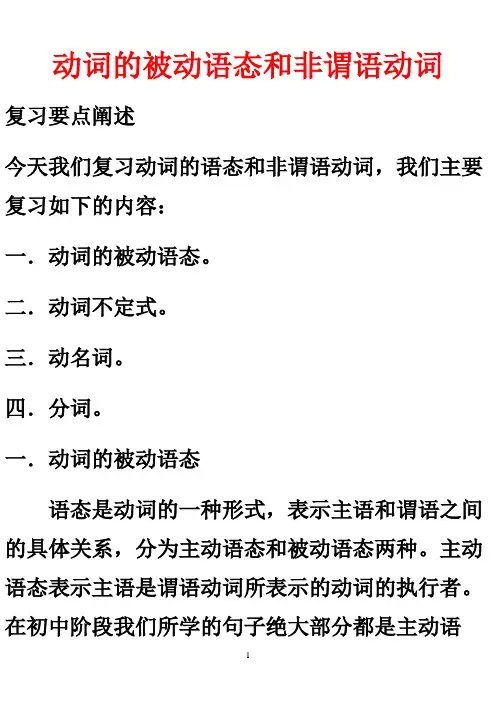
动词的被动语态和非谓语动词复习要点阐述今天我们复习动词的语态和非谓语动词,我们主要复习如下的内容:一.动词的被动语态。
二.动词不定式。
三.动名词。
四.分词。
一.动词的被动语态语态是动词的一种形式,表示主语和谓语之间的具体关系,分为主动语态和被动语态两种。
主动语态表示主语是谓语动词所表示的动词的执行者。
在初中阶段我们所学的句子绝大部分都是主动语态。
今天我们主要复习被动语态,被动语态表示主语不是动作的执行者,而是谓语动词所表示的动作的承受者。
(一)被动语态的构成1.被动语态的基本结构:be+动词过去分词2.各种时态的主动被动语态结构(以动词do为例)(二)被动语态的用法被动语态中主语是动作的承受者,主要用于下列几种情况1.不知道动作的执行者是谁。
watch is made in China.这块手表是在中国制造的。
2.没有必要指出动作的执行者是谁。
trees must be planted every year.每年必须有更多的树被种植。
3.需要强调或突出动作的承受者时。
is spoken by more and more people in the world.世界上越来越多的人说汉语(强调汉语的使用广泛)。
4.动作的发出者不是人时。
houses were washed away in the flood.很多房屋在洪水中被冲走了。
(三)主动语态和被动语态的转换1.主动语态变被动语态:(1)要将主动句里的宾语成分变为被动句中的主语成分,若主动句中的宾语是人称代词,要将宾格变主格。
(2)把主动句中的主语变为被动句中的宾语,主格变宾格,并由by引导。
(3)谓语动词变成相应的被动形式。
ask ed him to sing an English song.我们让他唱一首英语歌。
He was asked to sing an English song by us.他被我们要求唱一首英语歌。
2.带双宾语的谓语动词变为被动语态谓语动词带双宾语时,既可以将间接宾语转化成主语,也可接直接宾语转化成主语。
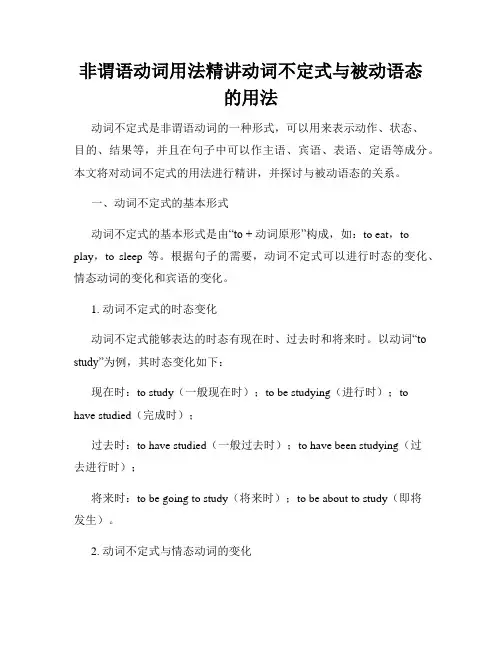
非谓语动词用法精讲动词不定式与被动语态的用法动词不定式是非谓语动词的一种形式,可以用来表示动作、状态、目的、结果等,并且在句子中可以作主语、宾语、表语、定语等成分。
本文将对动词不定式的用法进行精讲,并探讨与被动语态的关系。
一、动词不定式的基本形式动词不定式的基本形式是由“to + 动词原形”构成,如:to eat,to play,to sleep等。
根据句子的需要,动词不定式可以进行时态的变化、情态动词的变化和宾语的变化。
1. 动词不定式的时态变化动词不定式能够表达的时态有现在时、过去时和将来时。
以动词“to study”为例,其时态变化如下:现在时:to study(一般现在时);to be studying(进行时);to have studied(完成时);过去时:to have studied(一般过去时);to have been studying(过去进行时);将来时:to be going to study(将来时);to be about to study(即将发生)。
2. 动词不定式与情态动词的变化情态动词与动词不定式联用时,情态动词的形式保持不变,而动词不定式则仍保持原来的基本形式。
如:I can swim.(我会游泳。
)She must be careful.(她必须小心。
)He should apologize.(他应该道歉。
)3. 动词不定式作宾语动词不定式常常作为动词的宾语,说明动作或状态的对象。
常见的动词有want, hope, decide, plan, try, like等。
如:She wants to learn Chinese.(她想学中文。
)I hope to visit Beijing next year.(我希望明年去北京。
)4. 动词不定式作表语动词不定式还可以作表语,说明主语的身份、职业、爱好等。
如:Her dream is to be a teacher.(她的梦想是成为一名教师。
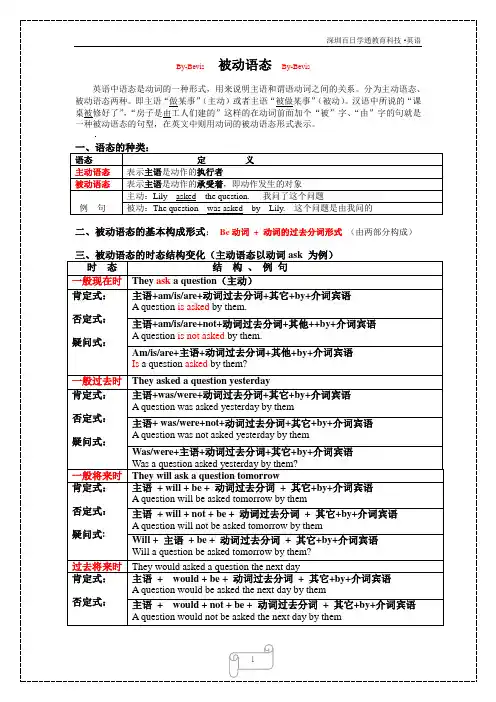
By-Bevis 被动语态By-Bevis英语中语态是动词的一种形式,用来说明主语和谓语动词之间的关系。
分为主动语态、被动语态两种。
即主语“做某事”(主动)或者主语“被做某事”(被动)。
汉语中所说的“课桌被修好了”,“房子是由工人们建的”这样的在动词前面加个“被”字、“由”字的句就是一种被动语态的句型,在英文中则用动词的被动语态形式表示。
一、语态的种类:语态定义主动语态表示主语是动作的执行者被动语态表示主语是动作的承受着,即动作发生的对象例句主动:Lily asked the question. 我问了这个问题被动:The question was asked by Lily. 这个问题是由我问的二、被动语态的基本构成形式:Be动词+ 动词的过去分词形式(由两部分构成)三、被动语态的时态结构变化(主动语态以动词ask 为例)时态结构、例句一般现在时They ask a question(主动)肯定式:否定式:疑问式:主语+am/is/are+动词过去分词+其它+by+介词宾语A question is asked by them.主语+am/is/are+not+动词过去分词+其他++by+介词宾语A question is not asked by them.Am/is/are+主语+动词过去分词+其他+by+介词宾语Is a question asked by them?一般过去时They asked a question yesterday肯定式:否定式:疑问式:主语+was/were+动词过去分词+其它+by+介词宾语A question was asked yesterday by them主语+ was/were+not+动词过去分词+其它+by+介词宾语A question was not asked yesterday by themWas/were+主语+动词过去分词+其它+by+介词宾语Was a question asked yesterday by them?一般将来时They will ask a question tomorrow肯定式:否定式:疑问式: 主语+ will + be + 动词过去分词+ 其它+by+介词宾语A question will be asked tomorrow by them主语+ will + not + be + 动词过去分词+ 其它+by+介词宾语A question will not be asked tomorrow by themWill + 主语+ be + 动词过去分词+ 其它+by+介词宾语Will a question be asked tomorrow by them?过去将来时They would asked a question the next day肯定式:否定式:主语+ would + be + 动词过去分词+ 其它+by+介词宾语A question would be asked the next day by them主语+ would + not + be + 动词过去分词+ 其它+by+介词宾语A question would not be asked the next day by them疑问式:Would + 主语+ be + 动词过去分词+ 其它+by+介词宾语Would a question be asked the next day by them?现在进行时They are asking a question now肯定式:否定式:疑问式:主语+ am/is/are + being +动词过去分词+其它+by+介词宾语A question is being asked now by them主语+am/is/are+being+not+动词过去分词+其它+by+介词宾语A question is being not asked now by them.Am/Is/Are+主语+being+动词过去分词+其它+by+介词宾语Is a question being asked now by them?过去进行时They were asking a question at that time肯定式:否定式:疑问式:主语+was/were+being+动词过去分词+其它+by+介词宾语A question was being asked at that time by them主语+was/were+being+动词过去分词+其它+by+介词宾语A question was being asked at that time by themWas/were+主语+being+动词过去分词+其它+by+介词宾语Was a question being asked at that time by them?现在完成时They have asked a question肯定式:否定式:疑问式:主语+have/has +been+动词过去分词+其它+by+介词宾语A question has been asked by them主语+have/has+not+been+动词过去分词+其它+by+介词宾语A question has not been asked by themHave/Has+主语+been+动词过去分词+其它+by+介词宾语Has a question been asked by them?过去完成时They had asked a question肯定式:否定式:疑问式:主语+had+been+动词过去分词+其它+by+介词宾语A question had been asked by them主语+ had+not+been+动词过去分词+其它+by+介词宾语A question had not been asked by themHad+主语+been+动词过去分词+其它+by+介词宾语Had aquestion been asked by them?情态动词They can ask a question肯定式:否定式:疑问式:主语+情态动词+be+动词过去分词+其它+by+介词宾语A question can be asked by them主语+情态动词+not+be+动词过去分词+其它+by+介词宾语A question can not be asked by them情态动词+主语+ +be+动词过去分词+其它+by+介词宾语Can a question be asked by them?be going to They are going to ask a question肯定式:否定式:疑问式:主语+be going to+be+动词过去分词+其它+by+介词宾语A question is going to be asked by them主语+ be going to +be+动词过去分词+其它+by+介词宾语A question is not going to be asked by themBe going to +主语+ +be+动词过去分词+其它+by+介词宾语Is a question going to be asked by them?练习:用横线划出下列句子的主语、谓语动词、宾语,并改成被动语态1.Students clean the classroom every day2. She is taking care of the children3. Someone has turned on the light4. They can finish all the work before July 20th5. We were building a new system now6. My cousin gave me a present last Christmas7. Our government will set up a new hospital next year8. She told them to wait her for a moment9. They are going to go over again this lesson this night10. She had handed in the paper before Miss wang came in四、主动语态与被动语态的互换1.主动语态:主语+ 谓语动词+ 宾语+ 状语Eg. We clean the classroom every day.被动语态:主语+ be+动词过去分词+ 状语+ by+介词宾语The classroom is cleaned every day by us2.主动语态:主语+ 谓语动词+ 间接宾语+ 直接宾语+ 状语He gave me five yuan yesterday被动语态:主语+ be + 动词过去分词+ 保留宾语(直宾/间宾) + 状语+ by介词宾语Eg. I was given five yuan yesterday by him Five yuan was given to me yesterday by him练习:将下列主动语态变成被动语态1. I write a letter every day2. Eli showed us a photo of his family(2种方法)3. He gave me a present4. We call her our good doctor5. They kept us waiting for a long time6. She will look after the children7. You should clean your room every day8. We respect our teachers五、被动语态的用法基本用法例句1.不知道或没必要说出动作的执行者时,by 短语常省略1.Paper was first invented in China.纸是中国首先发明的(不知是谁)2. Our school was set up in 2003我们学校是03年建立的(不必指明是谁建立的)2.强调动作的承受者时1.These boys are taken good care of by her. (强调这些孩子)这些孩子由她很好的照顾着2. Many houses were destroyed in the flood很多房屋被洪水摧毁3. 科技文献或新闻报道为体现客观性1. It is said that this disease is caused by a specific virus据报道,这种病是由一种特殊的病毒引起的4. 为表礼貌或委婉,避免提及动作执行者或说话人自己1. Smoking is not allowed in the library图书馆禁止吸烟2. Everybody is expected to obey the following rules希望大家遵守以下规定六、主动不能变被动的情况不能变被动的情况例句不及物动词作谓语We study hard 我们努力学习及物动词的宾语是表地点、处所、组织、国家等名称时1.He left his hometown ten years ago他10年前离开了家乡2.The students entered the classroom one by one学生们陆续地进了教室某些表状态或关系的及物动词、短语动词,只有主动语态四个“发生”:happen, take place, occur, break outLook like看起来像,mean意味着,own拥有,join参加,等…eg: In the past 30 years, great changes has taken plance in our country 在过去的30年,我们国家发生了巨大的变化There be句型There are a lot of deskes in the classroom教室里有许多桌子主系表句型He is a clever boy. 他是个聪明的男孩have作谓语动词We have three meals a day. 我们一日吃三餐反身代词作宾语He taught himself English.他自学英语相互代词作宾语They know each other. 他们彼此认识动名词、不定式作宾语1.They enjoy swimming with us他们喜欢和我们一起游泳2.She wants to be a teacher.她想成为一位老师There be句型There are a lot of desks in the classroom教室里有许多桌子七、用主动表被动的一些情况1. worth“值得”后接动词ing,用主动形式表被动意义The book is worth reading 这本书值得一读2系动词用主动表被动:smell闻起来,taste尝起来,look看起来,sound听起来,feel感觉起来The food tasted delicious. 这食物很好吃3.有些有及物动词转化的不及物动词,当主语为物时,由主动表被动:sell卖,write写,wash洗,wear穿,read读,等…The pen writes well这笔很好写The cloth washes well easily这布很容易洗注:1. A make / let / have B do “A使B做某事”变被动语态时需改成B is /are made/had/let to do…“B被迫做某事”eg: His parents make him study hard at home他父母让他每天努力学习He was made to study hard at home 他被迫在家努力学习2. Have sth done “让某事被做”, have后接物时,用动词过去分词形式表被动eg: I must have my bike repaired, it is broken. 我的单车坏了,我必须修理它练习:一、用动词的适当形式填空1. The War (break) out in 19372. Chinese (speak) by more and more people around the world3. We (tell)to close the windows before lefting the lab4. I don’t think sixteen-year-olds should (allow) to go to bars5. How long have Mr. And Mrs.David (marry) ?6. They (make) give up the picnic by the heavy rain7. This world can’t (understand) by the foreigners8. Lily’s bedroom is too dirty, she must have it (clean) now9. Workers (make) work from morning to night in the past10. All the work must (do) in two days11. The water is too dirty for us (swim)in.12. I often make him (laugh) druing the break time13. the trees (plant) in the park next Saturday?14. Thy often (help) each other15. She is a good cook, the fish (taste) delicious16. This beautiful song is wonderful , it worth (listen)17. Bikes widely (use) by Chinese18. When this kind of computer (use)?19. This kind of desk (make) of wood20. My brother (build) a new plane model these days二、按要求转换句型1. The book may be kept for two weeks. (对画线部分提问)the book ? 2. We have collected about one thousand models (对画线部分提问)Stamps collected?3.We must send her to a hospital at once (改为被动语态)must to a hospital at once4.You can renew the book for another week. (改为被动语态)The book for another week5. . Rice is grown in the south of China (改成主动语态,people作主语)in the south of China6. Your homework must be handed in today (改成主动语态)in your homework today7. the boy, the glass, by, broken, was (连词成句)8. factory, small, this, kind, made, is, a , bike, of, in (连词成句)9. 工人们在过去被迫一天工作12小时The workers for 12hours a day一、用动词的适当形式填空1. The War (break) out in 19372. Chinese (speak) by more and more people around the world3. We (tell)to close the windows before lefting the lab4. I don’t think sixteen-year-olds should (allow) to go to bars5. How long have Mr. And Mrs.David (marry) ?6. They (make) give up the picnic by the heavy rain7. This world can’t (understand) by the foreigners8. Lily’s bedroom is too dirty, she must have it (clean) now9. Workers (make) work from morning to night in the past10. All the work must (do) in two days11. The water is too dirty for us (swim)in.12. I often make him (laugh) druing the break time13. the trees (plant) in the park next Saturday?14. Thy often (help) each other15. She is a good cook, the fish (taste) delicious16. This beautiful song is wonderful , it worth (listen)17. Bikes widely (use) by Chinese18. When this kind of computer (use)?19. This kind of desk (make) of wood20. My brother (build) a new plane model these days二、按要求转换句型1. The book may be kept for two weeks. (对画线部分提问)the book ? 2. We have collected about one thousand models (对画线部分提问)Stamps collected?5.We must send her to a hospital at once (改为被动语态)must to a hospital at once6.You can renew the book for another week. (改为被动语态)The book for another week5. . Rice is grown in the south of China (改成主动语态,people作主语)in the south of China6. Your homework must be handed in today (改成主动语态)in your homework today7. the boy, the glass, by, broken, was (连词成句)8. factory, small, this, kind, made, is, a , bike, of, in (连词成句)9. 工人们在过去被迫一天工作12小时The workers for 12hours a day。
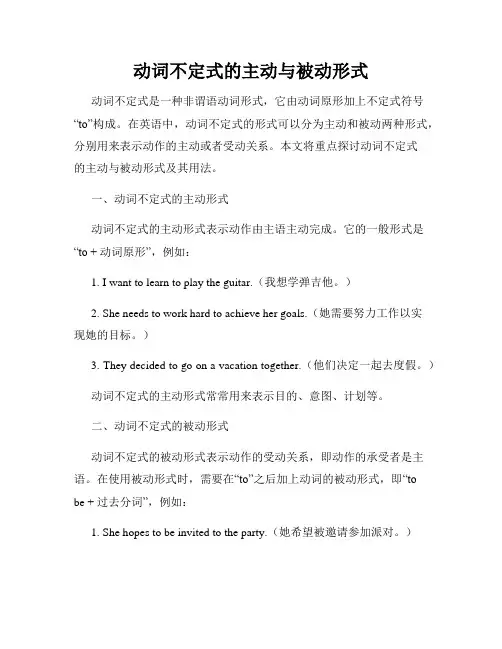
动词不定式的主动与被动形式动词不定式是一种非谓语动词形式,它由动词原形加上不定式符号“to”构成。
在英语中,动词不定式的形式可以分为主动和被动两种形式,分别用来表示动作的主动或者受动关系。
本文将重点探讨动词不定式的主动与被动形式及其用法。
一、动词不定式的主动形式动词不定式的主动形式表示动作由主语主动完成。
它的一般形式是“to + 动词原形”,例如:1. I want to learn to play the guitar.(我想学弹吉他。
)2. She needs to work hard to achieve her goals.(她需要努力工作以实现她的目标。
)3. They decided to go on a vacation together.(他们决定一起去度假。
)动词不定式的主动形式常常用来表示目的、意图、计划等。
二、动词不定式的被动形式动词不定式的被动形式表示动作的受动关系,即动作的承受者是主语。
在使用被动形式时,需要在“to”之后加上动词的被动形式,即“tobe + 过去分词”,例如:1. She hopes to be invited to the party.(她希望被邀请参加派对。
)2. They want to be recognized for their achievements.(他们希望因他们的成就而受到认可。
)3. He pretended to be surprised when he heard the news.(他假装听到消息后感到惊讶。
)被动形式通常用来表示动作的客观存在、被动接受等。
三、动词不定式主动与被动形式的用法1. 用于目的和意图动词不定式的主动形式常用于表示目的和意图,强调主语的主动性。
例如:- I bought a book to improve my English.(我买了一本书来提高我的英语水平。
)- He practices yoga every day to stay healthy.(他每天练习瑜伽保持健康。
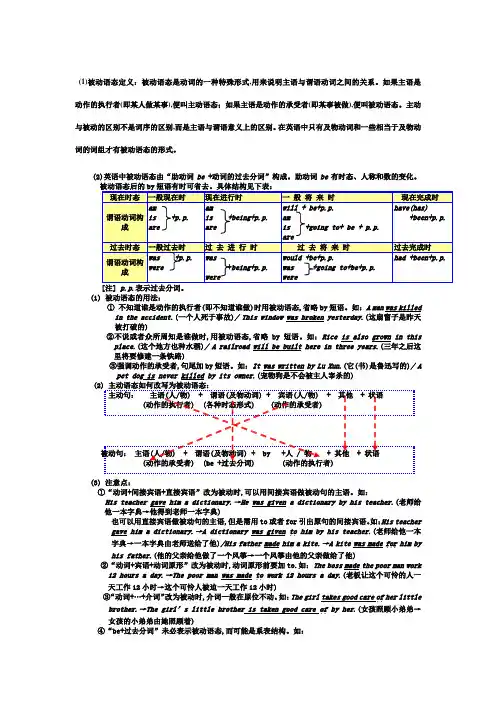
(1)被动语态定义:被动语态是动词的一种特殊形式,用来说明主语与谓语动词之间的关系。
如果主语是 动作的执行者(即某人做某事),便叫主动语态;如果主语是动作的承受者(即某事被做),便叫被动语态。
主动与被动的区别不是词序的区别,而是主语与谓语意义上的区别。
在英语中只有及物动词和一些相当于及物动词的词组才有被动语态的形式。
(2)英语中被动语态由“助动词be +动词的过去分词”构成。
助动词be 有时态、人称和数的变化。
(1) 被动语态的用法:① 不知道谁是动作的执行者(即不知道谁做)时用被动语态,省略by 短语。
如:A man was killedin the accident.(一个人死于事故)/ This window was broken yesterday .(这扇窗子是昨天被打破的)②不说或者众所周知是谁做时,用被动语态,省略by 短语。
如:Rice is also grown in this place.(这个地方也种水稻)/ A railroad will be built here in three years .(三年之后这里将要修建一条铁路)③强调动作的承受者,句尾加by 短语。
如:It was written by Lu Xun.(它(书)是鲁迅写的)/ Apet dog is never killed by its owner .(宠物狗是不会被主人宰杀的)(3) 注意点:①“动词+间接宾语+直接宾语”改为被动时,可以用间接宾语做被动句的主语。
如:His teacher gave him a dictionary.→He was given a dictionary by his teacher .(老师给他一本字典→他得到老师一本字典)也可以用直接宾语做被动句的主语,但是需用to 或者for 引出原句的间接宾语。
如:His teachergave him a dictionary.→A dictionary was given to ..him by his teacher.(老师给他一本字典→一本字典由老师送给了他)/His father made him a kite.→A kite was made for ...him byhis father .(他的父亲给他做了一个风筝→一个风筝由他的父亲做给了他)②“动词+宾语+动词原形”改为被动时,动词原形前要加to.如:The boss made the poor man work 12 hours a day.→The poor man was made to ..work 12 hours a day .(老板让这个可怜的人一天工作12小时→这个可怜人被迫一天工作12小时)③“动词+…+介词”改为被动时,介词一般在原位不动。
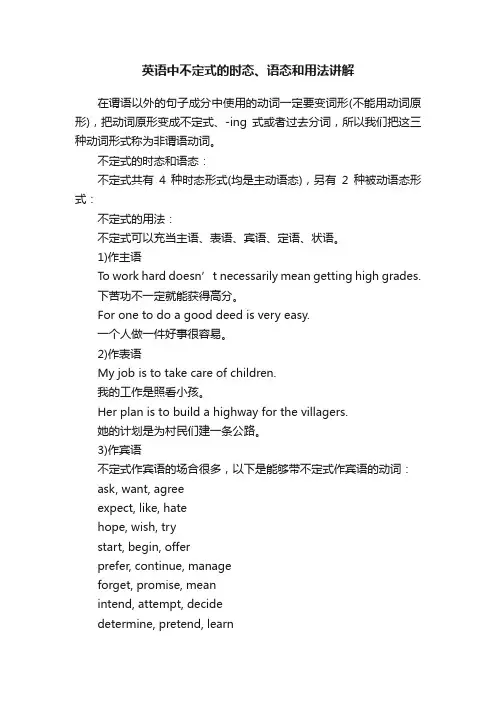
英语中不定式的时态、语态和用法讲解在谓语以外的句子成分中使用的动词一定要变词形(不能用动词原形),把动词原形变成不定式、-ing式或者过去分词,所以我们把这三种动词形式称为非谓语动词。
不定式的时态和语态:不定式共有4种时态形式(均是主动语态),另有2种被动语态形式:不定式的用法:不定式可以充当主语、表语、宾语、定语、状语。
1)作主语To work hard doesn’t necessarily mean getting high grades.下苦功不一定就能获得高分。
For one to do a good deed is very easy.一个人做一件好事很容易。
2)作表语My job is to take care of children.我的工作是照看小孩。
Her plan is to build a highway for the villagers.她的计划是为村民们建一条公路。
3)作宾语不定式作宾语的场合很多,以下是能够带不定式作宾语的动词:ask, want, agreeexpect, like, hatehope, wish, trystart, begin, offerprefer, continue, manageforget, promise, meanintend, attempt, decidedetermine, pretend, learndesire, choose, telladvise, show, discussI asked to be the first volunteer.我要求当第一名志愿者。
Do you want to leave here?你想要离开这里?We all agreed to do the spring cleaning.我们都同意过进行春季大扫除的。
He hopes to be chosen.他希望被选中。
有几十个动词后面不能接不定式作宾语,只能接-ing式,查阅公众号宾语部分。
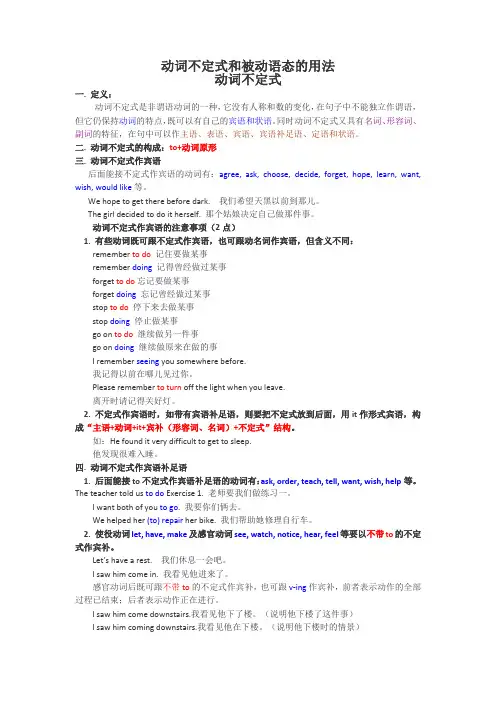
动词不定式和被动语态的用法动词不定式一. 定义:动词不定式是非谓语动词的一种,它没有人称和数的变化,在句子中不能独立作谓语,但它仍保持动词的特点,既可以有自己的宾语和状语。
同时动词不定式又具有名词、形容词、副词的特征,在句中可以作主语、表语、宾语、宾语补足语、定语和状语。
二. 动词不定式的构成:to+动词原形三. 动词不定式作宾语后面能接不定式作宾语的动词有:agree, ask, choose, decide, forget, hope, learn, want, wish, would like等。
We hope to get there before dark. 我们希望天黑以前到那儿。
The girl decided to do it herself. 那个姑娘决定自己做那件事。
动词不定式作宾语的注意事项(2点)1. 有些动词既可跟不定式作宾语,也可跟动名词作宾语,但含义不同:remember to do记住要做某事remember doing记得曾经做过某事forget to do忘记要做某事forget doing忘记曾经做过某事stop to do停下来去做某事stop doing停止做某事go on to do继续做另一件事go on doing继续做原来在做的事I remember seeing you somewhere before.我记得以前在哪儿见过你。
Please remember to turn off the light when you leave.离开时请记得关好灯。
2. 不定式作宾语时,如带有宾语补足语,则要把不定式放到后面,用it作形式宾语,构成“主语+动词+it+宾补(形容词、名词)+不定式”结构。
如:He found it very difficult to get to sleep.他发现很难入睡。
四. 动词不定式作宾语补足语1. 后面能接to不定式作宾语补足语的动词有:ask, order, teach, tell, want, wish, help等。
英语被动语态例句与讲解【典型例句呈现】1. The students are made to write a composition every other day.2. Thousands of people got killed in the Indian Ocean Tsunami.3. Effective measures have to be taken to combat bird flu.4. The poem reads smoothly.5. I am very surprised at your response.6. The flowers are being watered.7. They were reported to have been sent into the moon last year.8. More trees will be planted in spring next year.9. The exit sign may be stuck on the side door.10. Generally speaking, no one likes being made fun of in public.【用法小结】1. 当动词不定式在一些动词后面作宾语补足语时,在被动语态中不能省略to,这组动词为感官动词(see, hear, watch, notice, observe 等)和使役动词(make, have 等)。
(例1)2. get 用于被动语态,相当于be。
(例2)3. 根据语境需要选择恰当的情态动词用于被动语态,表能力,义务,可能性等。
(例3,9)4. 有些动词用主动形式表示被动意思。
(例4) 又如:(1) Cotton doesn’t dry quickly.(2) The door won’t shut.(3) The pen writes smoothly.5. 有些动词形式上是被动语态,但功能是形容词。
不定式的用法和动词不定式的时态动词不定式是英语语法中的一种形式,它由不定式标志to加上动词的原形构成。
不定式在句子中可以充当名词、形容词或副词,具有一定的时态和语态。
一、不定式的基本用法1. 作主语:动词不定式可以在句子中作主语,表示某种动作、状态或观点。
- To learn a foreign language is important.- To be honest is always appreciated.2. 作宾语:动词不定式可以作及物动词的宾语,表示及物动词的动作或含义。
- I want to travel around the world.- She decided to quit her job.3. 作表语:动词不定式可以作系动词的表语,表示主语的身份、职业、特点等。
- Her dream is to become a doctor.- The important thing is to keep calm in any situation.4. 作定语:动词不定式可以修饰名词或代词,表示名词或代词的用途、目的等。
- I have a book to read.- We have a meeting to attend tomorrow.5. 作状语:动词不定式可以在句中作状语,表示目的、原因、结果、时间等。
- He exercises every day to stay healthy. (目的)- She cried so hard as to lose her voice. (结果)二、动词不定式的时态动词不定式有两种时态:一般时和完成时。
1. 一般时不定式:使用动词的原形表示不定式的一般时态。
- I hope to visit my grandparents next week.- She likes to read books in her free time.2. 完成时不定式:使用动词的完成时形式,由“to have + 动词的过去分词”构成。
动词不定式的被动语态要点归纳1. 一般来说,如果动词不定式的逻辑主语是动作的执行者,动词不定式用主动式;如果动词不定式的逻辑主语是动作的承受者,动词不定式用被动式。
如:He gave orders for the work to be done at once. 他下令那项工作要立刻完成。
〔“work〞为动词不定式的逻辑主语,“to do〞这个动作不是逻辑主语发出的,故动词不定式要用被动式〕He ordered us to do the work at once. 他命令我们立刻完成那项工作。
〔“us〞为动词不定式的逻辑主语,“to do〞这个动作是逻辑主语发出的,故动词不定式用主动式〕2. 在“主语+ be + 形容词或某些名词+ 动词不定式〞构造中,常可看作是省略了动词不定式的逻辑主语for sb 构造,故动词不定式用主动式。
如:The car is difficult (for us) to repair. 这辆汽车很难修理。
The book is great fun (for us) to read. 这本书读起来很有趣。
She is not easy (for us) to get along with. 她不大容易相处。
3. There be 构造后面的动词不定式用主动语态或被动语态均可;有时意义有所不同,应根据特定的语境来确定其形式。
如:There is a lot to do / to be done today. 今天有很多事要做。
There is nothing to do now. 现在没什么事可做。
There is nothing to be done now. 现在没有什么方法。
4. 动词不定式作定语时,如果句子的主语或宾语是动词不定式的逻辑主语,该动词不定式用主动式。
如:He has two letters to write tonight. 他今晚有两封信要写。
〔“He〞为动词不定式的逻辑主语〕You have given me much to read. 你让我看的东西已经很多了。
动词不定式的用法讲解动词不定式是英语语法中的一个重要部分,它具有丰富的用法和多样的功能。
理解和掌握动词不定式对于学好英语、正确表达意思至关重要。
接下来,让我们详细探讨一下动词不定式的用法。
一、作主语动词不定式作主语时,通常表示具体的、一次性的或未发生的动作。
为了保持句子平衡,常用 it 作形式主语,而将真正的主语(动词不定式)后置。
例如:“To learn English well is not easy”(学好英语不容易。
)但这个句子头重脚轻,所以通常会改为:“It is not easy to learn English well”二、作宾语有些动词后只能接动词不定式作宾语,常见的这类动词有:want(想要),hope(希望),wish(希望),decide(决定),plan(计划),expect(期望)等。
比如:“I want to go shopping this weekend”(这个周末我想去购物。
)“She decided to study harder”(她决定更努力学习。
)三、作宾语补足语某些动词后需要用动词不定式作宾语补足语,常见的有:ask(要求),tell(告诉),want(想要),allow(允许),encourage(鼓励)等。
例如:“My mother asks me to clean my room every day”(我妈妈每天要求我打扫房间。
)“The teacher encourages us to speak English more”(老师鼓励我们多说英语。
)四、作定语动词不定式作定语时,通常放在被修饰词之后,与被修饰词之间存在逻辑上的动宾关系。
例如:“I have a lot of work to do”(我有很多工作要做。
)“There is no time to waste”(没有时间可以浪费。
)五、作状语1、目的状语动词不定式可以作目的状语,表示某一动作或行为的目的。
被动语态(Ⅰ):动词不定式的被动式不定式修饰的名词或代词和不定式构成逻辑上的动宾关系,即当不定式的逻辑主语是不定式所表示动作的承受者时,不定式一般使用被动式。
一、动词不定式被动式的构成和意义The next thing to be done is to carry away the earth.下一步要做的事是把土运走。
No harm seems to have been done to them.对他们似乎并没有造成损害。
[考题印证]1①(山东高考改编)George returned after the war, only (tell) that his wife had left him.②(湖南高考改编)We've had a good start, but next, more work needs(do) to achieve the final success.二、动词不定式被动式的用法1.作主语It is an honour to be chosen as a volunteer.能被选上做志愿者,真是一件荣幸的事情。
2.作表语The task is to be finished by next month.这项工作要在下个月才能完成。
3.作宾语The boy asked to be given an opportunity to try again.那男孩要求给他再试一次的机会。
4.作宾语补足语He ordered the baggage to be brought to his room.他吩咐把行李搬进他的房间。
5.作定语He was the last one to be asked to speak at the meeting.他是最后一个在会上被邀请发言的人。
6.作状语His mother left the small village, never to be seen again.他母亲离开了那个小村庄,再也没人见过她。
动词不定式被动语态的例子《关于动词不定式被动语态那些事儿》嘿呀,说起动词不定式被动语态的例子呀,那可真是有意思得很!它就像是英语语法世界里的一个调皮小精灵,时不时就出来蹦跶一下,让人又爱又恨。
咱先说说“To be loved”,这就是个典型的动词不定式被动语态例子。
你看哈,它的意思是“被爱”。
想象一下,就好像有人在那儿等着被宠爱、被疼惜。
这感觉多奇妙啊,自己啥也不用干,就等着“被爱”这个好事降临。
再比如“To be eaten”,“被吃”。
嘿,这让我想起了摆在餐桌上的美食,它们可不就是等着被我们这些吃货给吃掉嘛。
它们没办法主动干啥,只能乖乖地在那,等着被动地被送进我们的嘴巴里,然后在我们的肚子里开始一场奇妙的旅行。
要说这动词不定式被动语态啊,有时候真是让人哭笑不得。
你想啊,要是啥都用主动的,那多没意思。
就比如说,“The book needs to read”,这一读就觉得怪怪的,书怎么主动去读自己呢?但是一旦改成“To be read”,那就对味啦,书需要“被读”,这才符合常理嘛!这就像是一个角色转变,一下子从主动的“主角”变成了等待被摆弄的“小可怜”。
还有啊,有时候我们说话的时候,不小心就把这小精灵给弄错了。
比如说,本该用“To be done”的时候,说成了“To do”,那就闹笑话啦!就像要去坐火车,结果上错了车,那可就南辕北辙啦。
在我学习英语的过程中,这动词不定式被动语态的例子可没少让我头疼。
有时候看着那些句子,就感觉那些单词在我脑袋里乱成一团,怎么都理不清楚。
但是呢,每当我搞懂一个例子,又会特别有成就感,就好像攻克了一个小城堡一样。
总的来说呀,动词不定式被动语态的例子虽然有时候让人觉得有点难搞,但它们也是英语语法世界里不可或缺的一部分。
就像生活中的小挑战一样,虽然会让我们苦恼一下,但克服了之后,那感觉真是爽歪歪!所以啊,大家也别害怕这些小精灵,多和它们过过招,慢慢地就会发现它们其实也没那么可怕啦!让我们和动词不定式被动语态的例子一起愉快地玩耍吧!。
Book7 unit2动词不定式被动语态形一、复习各种时态的被动语态★被动语态的基本结构: be+ done(以the book , publish 为例)一般现在/过去时:The book is/ was published.一般/过去将来时:The book will/would be published.The book is/was going to be published.现在/过去进行时:The book is/was being published.现在/过去完成时:The book has/had been published.情态动词:The book can/could/may/might…be published.1)一般式:(not/never )to be done2)完成式:(not/ never)to have been done (表示不定式动作发生在谓语动词之前)三、▲通常在believe, suppose, say, report等动词构成的句子中可以进行主动语态到被动语态以及被动语态和动词不定式的转换.如:They say that Mike is sick in bed.=It is said that Mike is sick in bed.=Mike is said to be sick in bed.据说麦克卧床不起.People believe that he was killed.=It is believed that he was killed.=He is believed to have been killed.大家相信他被杀了.四、当不定式的逻辑主语是不定式所表示的动作的承受者而非发出者时,不定式一般要采用被动形式(to be done).语法功能:1.作主语:It is an honour for me to be asked to speak here.2.作宾语:She asked to be sent to work in Xinjiang.3.构成复合宾语:He wanted the letter to be typed at once.She didn’t like herself to be praised like that.4.构成复合谓语:The books are not allowed to be taken out of the room.5.作定语:Are you going to the meeting to be held in the teachers’ office?6.作状语:She was too young to be assigned such work.五、不定式有时还可以有完成式的被动式to have been done(表示该动作是发生在主句之前的一个被动动作),在句中作主语、宾语、定语,或者构成复合宾语、复合谓语等,如:It is a good thing for him to have been criticized.(主语)She preferred to have been given heavier work to do. (宾语))He thought it an honour to have been invited to the party. (复合宾语)The book is said to have been translated into many languages. (复合谓语)She was the first woman to have been elected to such a post. (定语)六、不定式的主动形式表示被动1.There be 结构中,用不定式的主动和被动式来修饰主语,区别不大。
(多用主动形式)例如:There is a lot of work to do / to be done.There is no time to lose /to be lost.译:没有什么可担心的。
________________________________There is nothing to worry about.注意以下两点:(1)如果不定式结构加了"for sb."表示的逻辑主语时There are still many questions for us to discuss. (us与discuss 主谓关系,用主动to discuss)There are a lot of reasons for the book to be published.(the book与publish是动宾关系,用被动to be published)(2)某些动词(do, see)的不定式特殊用法时,两种形式所表示的意思不同。
比较:There is nothing to do now. (We have nothing to do now.)There is nothing to be done now. (We can do nothing now.)There is nothing to see. (Nothing is worth seeing.)There is nothing to be seen. (Nothing is there at all.)2.在“主语+ be+ adj+ to do”句型中:常见的adj有hard,amusing,interesting, cheap,difficult,dangerous,easy,nice,important,pleasant.etc.That question is difficult to answer.He is an impossible person to work with.但若要强调句中的受事者,也可用不定式的被动式:The handwriting is difficult to be read.★注意:如果动词为不及物动词,则要注意介词的搭配。
John is difficult to deal with.分析:_________(动)----________(宾))译:这扶手椅坐起来很舒服。
___________________________________这题目很难算出来。
______________________________________The armchair is comfortable to sit inThe question is difficult to work out3. 当上述第2题中形容词在句中作宾语补足语,后接不定式:I found him easy to get along with.They don’t think the game interesting to play.I find the lecture difficult to understand.4.在“too—to do; enou gh…to…”结构中。
如:The problem is too difficult to work out (to be worked out).The house is big enough to live in.(不及物动词要补出相应的介词)但若要强调句中的受事者,也可用被动式:This box is too heavy to be lifted.5.在“with+n+to do”结构中。
(和逻辑主语是主动关系)例如:With nothing to do,he lay in bed.With so many exercises to do,I can‘t go to the cinema.6.当不定式的逻辑主语在句中出现时。
例如:I have a meeting to attend.。
(to attend与I有主谓关系,即I 是逻辑主语)Give him some books to read. (to read与him有主谓关系,即him 是逻辑主语)如果不属于上述情况,则表示被动意义时仍需要用被动形式。
试比较下面两句:1. Have you anything to do this afternoon?2. Have you anything to be taken to the city (by me or someone else) ?(to take 与you没有主谓关系, 即you不是逻辑主语)练习:填写括号中动词的适当形式1. I have a meeting ______ (attend) today.2. He gave me some books _______(read).3. I’m going to Beijing next week. Do you have anything __________(take) to your parents?7.一些作表语用的不定式的主动形式。
常见的这类动词有let(出租),rent,hire,blame等。
例如:The house is to rent. Nobody was to blame for the accident.但是,具有对比意义时,仍用被动形式。
例如:The room is to be rented, not to be sold.。
She is to be praised, not to be blamed.Exercise1. Having a trip abroad is certainly good for the old couple, but it remains____ whether they will enjoy it.A. to seeB. to be seenC. seeingD. seen2. I hurried to the meeting hall, only____ that the meeting had been put off.A. to tellB. to be toldC. tellingD. told3. Do let your mother know all the truth, she appears____ everything.A. to tellB. to be toldC. to be tellingD. to have been told4. Little Tom should love____ to the theater this evening.A. to be takenB. to takeC. being takenD. taking5. With a lot of problems____, the newly-elected president is having a hard time.A. settledB. settlingC. to settleD. being settled6. He___ and was made to repeat it.A. didn’t understandB. didn’t be understoodC. wasn’t understandD. wasn’t understood7. The pupils here____ all kinds of exercises every day in the past four weeks.A. kept busy doingB. keep on doingC. have kept busy doingD. have been kept busy doing语法检测一.根据括号内的动词填入正确形式。